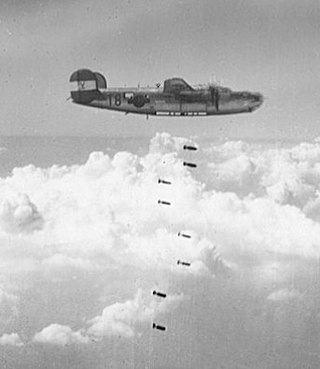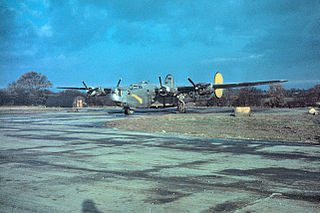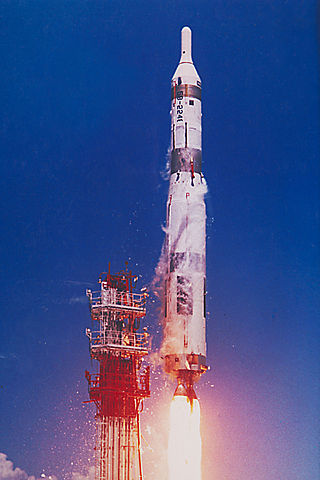
The 491st Bombardment Group is a former United States Army Air Forces unit. It was activated in October 1943 as a heavy bomber unit, drawing its cadre from the former 17th Antisubmarine Squadron. After training in the United States, the group deployed to the European Theater of Operations, where it participated in the strategic bombing campaign against Germany, earning a Distinguished Unit Citation in an attack against Misburg. The group flew 187 combat missions. Following V-E Day, the group returned to the United States and was inactivated at McChord Field, Washington in September 1945.

The 15th Special Operations Squadron is part of the 1st Special Operations Wing at Hurlburt Field, Florida. It operates Lockheed MC-130J Commando II aircraft in support of special operations.

The 820th Bombardment Squadron is a former Army Air Forces unit, inactivated on 4 January 1946. The squadron was first activated during World War II as the 521st Bombardment Squadron. The squadron was soon engaged in the antisubmarine campaign off the Atlantic coast of the United States as the 16th Antisubmarine Squadron.

The 867th Attack Squadron is an active United States Air Force unit. It was reactivated at Creech Air Force Base, Nevada, on 10 September 2012 as a remotely piloted aircraft squadron.

The 819th Bombardment Squadron is an inactive United States Air Force unit. Its last assignment was with the 30th Bombardment Group at Kahuku Army Air Field, Hawaii, where it was inactivated on 30 November 1945.

The 847th Bombardment Squadron is a former United States Army Air Forces unit that was originally activated as the 421st Bombardment Squadron. Its last assignment was with the 489th Bombardment Group at Great Bend Army Air Field, Kansas where it was inactivated on 28 March 1945. As the 20th Antisubmarine Squadron, the squadron performed antisubmarine patrols in 1942 and 1943. After reforming as a heavy bomber squadron, it engaged in the strategic bombing campaign against Germany in the European Theater of Operations until returning to the United States in late 1944. The squadron was inactivated while its parent group was training as a very heavy bombardment unit.

The 831st Bombardment Squadron was a squadron of the United States Army Air Forces. It was activated in 1942 as the 516th Bombardment Squadron and flew antisubmarine missions off the Atlantic coast as the 11th Antisubmarine Squadron. Later, it saw combat in the Mediterranean Theater of Operations as a Consolidated B-24 Liberator unit, where it earned a Distinguished Unit Citation during the strategic bombing campaign against Germany. Following V-E Day, the squadron returned to the United States and was inactivated at Sioux City Army Air Base, Iowa on 20 August 1945.

The 859th Special Operations Squadron is a reserve unit of the United States Air Force. It was first activated in October 1942 as the 517th Bombardment Squadron, when the Army Air Forces replaced National Guard observation units that had been mobilized and were performing antisubmarine patrols off the Atlantic coastline. A month after its activation, the squadron was redesignated the 12th Antisubmarine Squadron. In August 1943, the Army Air forces began turning the antisubmarine patrol mission over to the Navy and the squadron moved to California, where, as the 859th Bombardment Squadron, it formed the cadre for the 492d Bombardment Group.

The 835th Bombardment Squadron is an inactive United States Army Air Forces unit. It was activated in January 1941 as the 80th Bombardment Squadron and equipped with Douglas A-20 Havoc light bombers. Following the attack on Pearl Harbor the squadron began to fly antisubmarine patrols off the Atlantic coast and over the Caribbean Sea, becoming the 9th Antisubmarine Squadron.

The 863rd Bombardment Squadron is a former United States Army Air Forces unit. It was first organized as the 518th Bombardment Squadron in October 1942, when it replaced a National Guard unit participating in antisubmarine patrols off the Atlantic coast, becoming the 13th Antisubmarine Squadron in November. When the Navy took over the coastal antisubmarine mission in August 1943, the squadron moved to the western United States, where it formed the cadre for the 493rd Bombardment Group and was redesignated as the 863rd. It moved to England in the spring of 1944 and participated in the strategic bombing campaign against Germany until April 1945. It returned to the United States and was inactivated in August 1945.

The 851st Strategic Missile Squadron is an inactive United States Air Force unit. It was last assigned to the 456th Strategic Aerospace Wing, stationed at Beale Air Force Base, California. It was equipped with the HGM-25A Titan I intercontinental ballistic missile, with a mission of nuclear deterrence. It was the last Titan I squadron to achieve alert status on 1 February 1961. The squadron was inactivated as part of the phaseout of the Titan I on 25 March 1965.

The 492nd Special Operations Wing is a United States Air Forces unit stationed at Hurlburt Field, Florida. It was activated in May 2017 to replace the Air Force Special Operations Air Warfare Center.

The 852nd Bombardment Squadron is a former United States Army Air Forces unit. It was activated in October 1943 as a heavy bomber unit. After training in the United States, the squadron deployed to the European Theater of Operations, where it participated in the strategic bombing campaign against Germany, earning a Distinguished Unit Citation in an attack against Misburg. Following V-E Day, the squadron returned to the United States and was inactivated at McChord Field, Washington in September 1945.

The 853rd Bombardment Squadron was a United States Army Air Forces unit. It was activated in October 1943 as a heavy bomber unit. After training in the United States, the squadron deployed to Great Britain, where it participated in the strategic bombing campaign against Germany, earning a Distinguished Unit Citation in an attack against Misburg. Following V-E Day, the squadron returned to the United States and was inactivated at McChord Field, Washington in September 1945.

The 854th Bombardment Squadron is a former United States Army Air Forces unit. It was activated in October 1943 as a heavy bomber unit. After training in the United States, the squadron deployed to the European Theater of Operations, where it participated in the strategic bombing campaign against Germany, earning a Distinguished Unit Citation in an attack against Misburg. Following V-E Day, the squadron returned to the United States and was inactivated at McChord Field, Washington in September 1945.

The 827th Bombardment Squadron is a former United States Army Air Forces unit. It was last assigned to the 484th Bombardment Group at Casablanca Airport, French Morocco, where it was inactivated on 25 July 1945.

The 7th Bombardment Squadron is an inactive United States Air Force unit. It was last assigned to the 34th Bombardment Group at Sioux Falls Army Air Field, South Dakota, where it was inactivated on 28 August 1945.

The 839th Bombardment Squadron is an inactive United States Army Air Forces unit. It was activated in January 1941 as the 79th Bombardment Squadron and equipped with Douglas A-20 Havoc light bombers. Following the attack on Pearl Harbor the squadron began to fly antisubmarine patrols off the Atlantic coast and over the Caribbean Sea, becoming the 8th Antisubmarine Squadron.

The 6th Air Defense Missile Squadron was an air defense unit of the United States Air Force. It was assigned to the New York Air Defense Sector of Aerospace Defense Command, at Suffolk County Air Force Base, New York, where it was inactivated on 15 December 1964. The squadron had its headquarters at Suffolk County Air Force Base, while the firing batteries of the squadron were at the nearby Suffolk County Air Force Base Missile Annex.

The Army Air Forces Antisubmarine Command was formed in the fall of 1942 to establish a single command to control antisubmarine warfare (ASW) activities of the Army Air Forces (AAF). It was formed from the resources of I Bomber Command, which had been carrying out the antisubmarine mission in the Atlantic and Caribbean since the Attack on Pearl Harbor due to the lack of long range Naval aviation in that area.






















